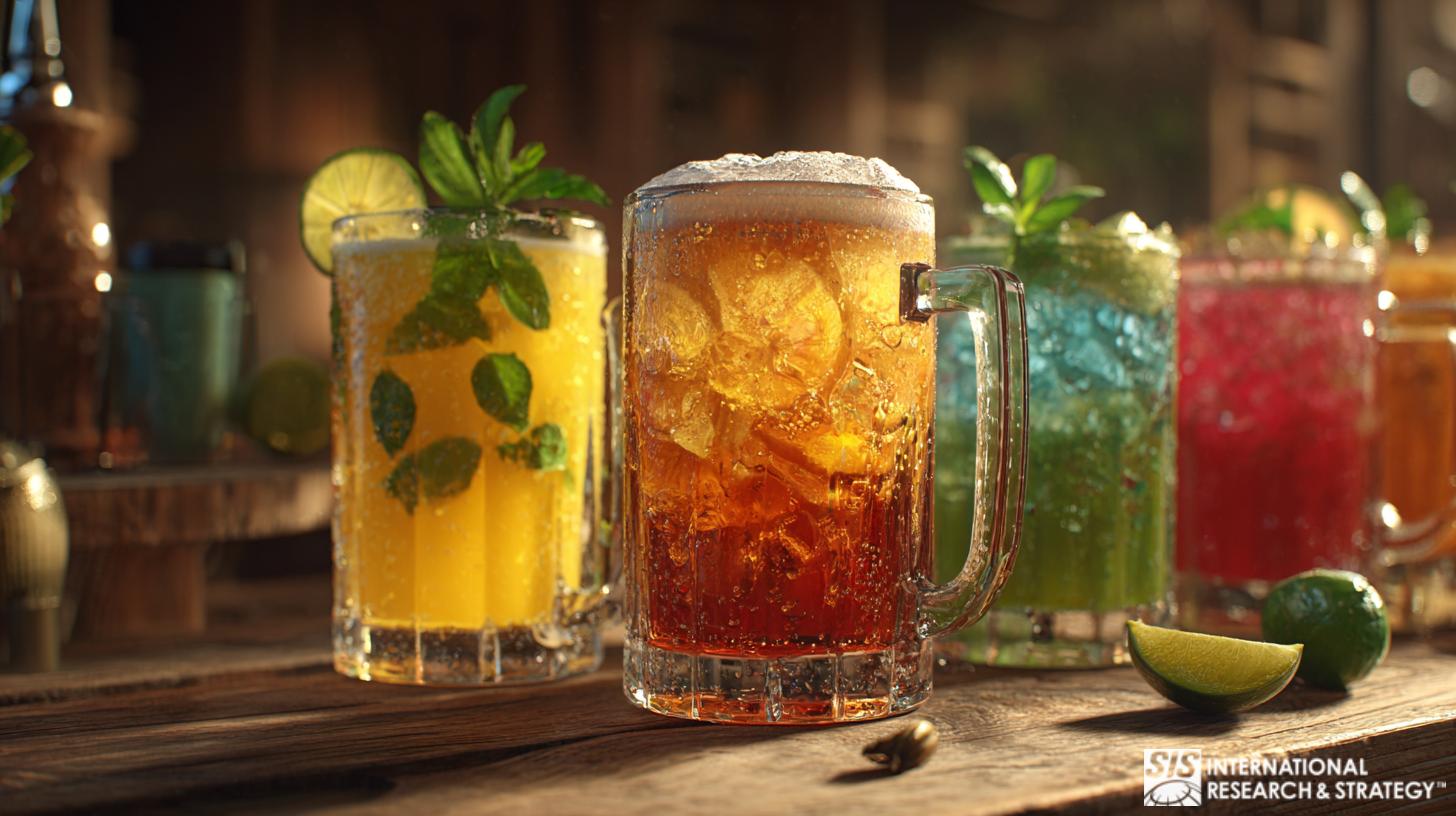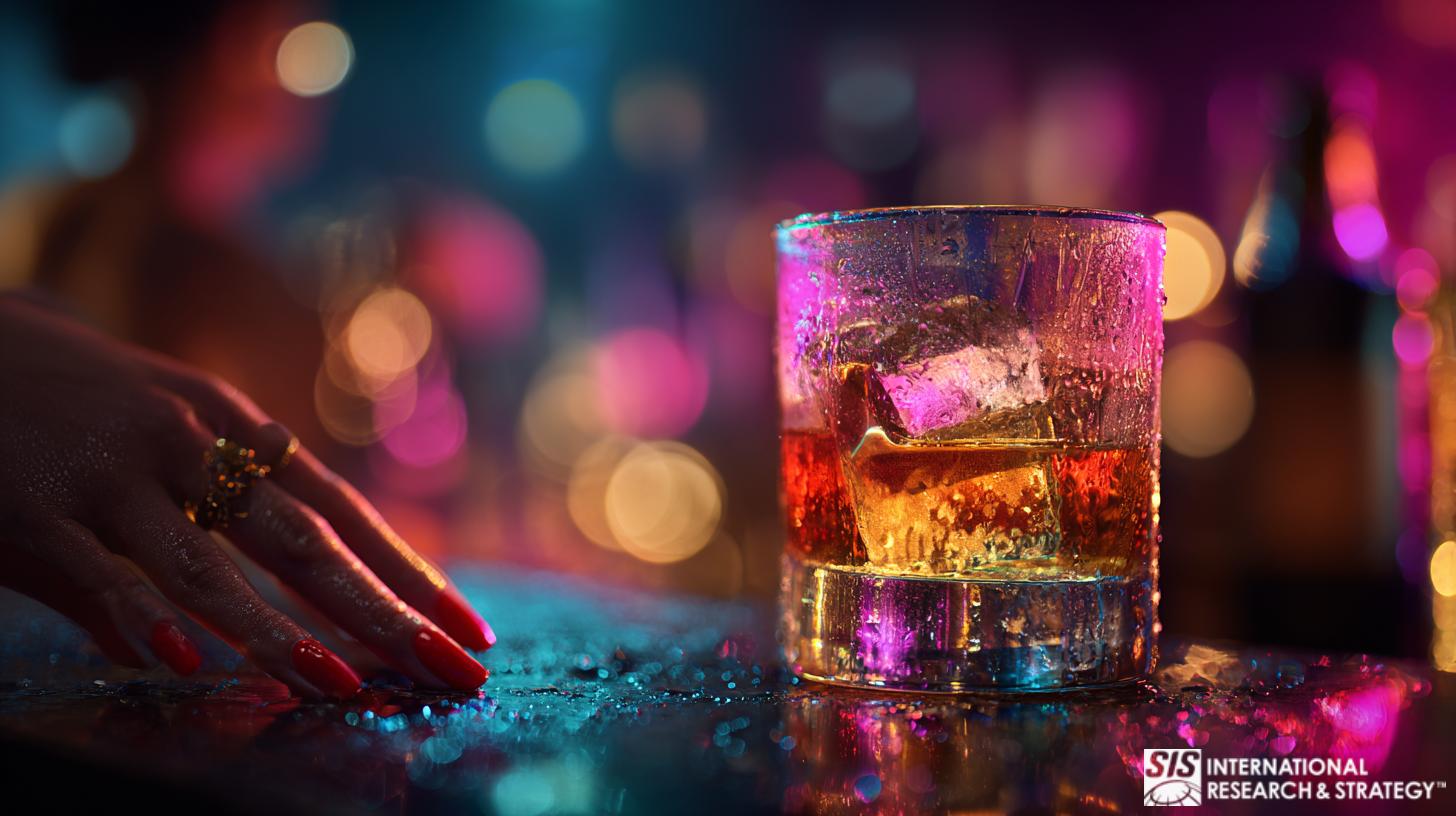การทดสอบรสชาติแอลกอฮอล์

การทดสอบรสชาติแอลกอฮอล์มีบทบาทสำคัญในอุตสาหกรรมเครื่องดื่ม ช่วยให้มั่นใจได้ถึงความสม่ำเสมอของโปรไฟล์รสชาติ ระบุข้อบกพร่องหรือรสชาติที่ผิดปกติ และแนะนำการพัฒนาผลิตภัณฑ์ใหม่ที่ตรงตามความต้องการของผู้บริโภค
แบรนด์ต่างๆ จะมั่นใจได้อย่างไรว่าเครื่องดื่มแอลกอฮอล์ของตนโดดเด่นและตอบสนองความคาดหวังในระดับสูงของนักเลงและผู้ดื่มทั่วไปอย่างสม่ำเสมอ งานฝีมือและศาสตร์แห่งการสร้างสรรค์เครื่องดื่มแอลกอฮอล์ที่สมบูรณ์แบบนั้นเป็นศิลปะอย่างหนึ่ง และการทดสอบรสชาติแอลกอฮอล์ถือเป็นก้าวสำคัญสู่ความสำเร็จของตลาด เพื่อให้มั่นใจว่าทุกจิบจะเป็นการเดินทางแห่งการค้นพบและความพึงพอใจของผู้บริโภค
ตable of Contents
การทดสอบรสชาติแอลกอฮอล์คืออะไร?
Alcohol taste testing is an in-depth analysis of the complex flavor profiles, aromas, and textures that define alcoholic beverages. It assesses the quality, character, and appeal of drinks, ranging from wines and spirits to beers and cocktails.
This taste testing evaluates the sensory characteristics of alcoholic beverages, including wine, beer, and spirits. It involves assessing appearance, aroma, taste, and mouthfeel to determine the beverage’s quality and characteristics.
During alcohol taste testing, trained professionals, known as “sensory panelists,” use their senses to identify and describe various beverage attributes, such as fruitiness, acidity, sweetness, and bitterness. These evaluations help producers understand consumer perceptions of their products and make informed decisions about product development and quality control.
เหตุใดธุรกิจจึงต้องมีการทดสอบรสชาติแอลกอฮอล์?

Alcohol taste testing is essential for ensuring product quality and consistency. It allows producers to identify variations and make the necessary adjustments to ensure that every product reaching consumers maintains the brand’s quality standards. This consistency is critical to building and maintaining consumer trust and loyalty, as customers expect the same experience with every purchase.
นอกจากนี้ การทดสอบรสชาติแอลกอฮอล์ยังเอื้อต่อการสร้างสรรค์นวัตกรรมและความแตกต่าง เนื่องจากผู้ผลิตสามารถทดลองใช้รสชาติ การผสม และเทคนิคการต้มเบียร์หรือการกลั่นใหม่ๆ เพื่อสร้างผลิตภัณฑ์ที่เป็นนวัตกรรมใหม่ที่ดึงดูดความสนใจของตลาด กระบวนการสำรวจและปรับปรุงนี้มีความสำคัญสำหรับแบรนด์ที่ต้องการเป็นผู้นำมากกว่าที่จะติดตามแนวโน้มของตลาด
นอกจากนี้ การทดสอบรสชาติแอลกอฮอล์ยังให้ข้อมูลเชิงลึกที่มีคุณค่าเกี่ยวกับความชอบของผู้บริโภค ช่วยให้แบรนด์ต่างๆ สามารถปรับแต่งผลิตภัณฑ์ของตนให้ตรงกับรสนิยมที่เปลี่ยนแปลงไปของกลุ่มเป้าหมายได้ อย่างไรก็ตาม ยังนำมาซึ่งประโยชน์อื่นๆ อีกมากมายสำหรับธุรกิจ ได้แก่:
- ความสอดคล้องระหว่างชุดงาน: การทดสอบรสชาติแอลกอฮอล์ช่วยให้แบรนด์ต่างๆ ติดตามความแปรผันได้อย่างใกล้ชิด และปรับวิธีการเพื่อให้แน่ใจว่าผู้บริโภคจะได้รับประสบการณ์การใช้ผลิตภัณฑ์ที่สอดคล้องกัน
- ความแตกต่างของตลาด: ผ่านการทดสอบรสชาติแอลกอฮอล์ แบรนด์ต่างๆ สามารถสำรวจการผสมผสานรสชาติที่เป็นนวัตกรรม เทคนิคการผลิต และโปรไฟล์ส่วนผสมที่เป็นเอกลักษณ์ที่ทำให้ผลิตภัณฑ์ของตนแตกต่างออกไป
- สอดคล้องกับความต้องการของผู้บริโภค: การทดสอบรสชาติแอลกอฮอล์ให้ข้อมูลเชิงลึกเกี่ยวกับรสนิยมและความชอบของตลาดเป้าหมาย ช่วยให้แบรนด์ต่างๆ สามารถปรับแต่งผลิตภัณฑ์ของตนให้ตรงตามความคาดหวังเหล่านี้ได้
- การเล่าเรื่องแบรนด์ที่ได้รับการปรับปรุง: ความแตกต่างและคุณภาพที่เปิดเผยผ่านการทดสอบรสชาติแอลกอฮอล์สามารถยกระดับการเล่าเรื่องของแบรนด์ ทำให้สามารถบอกเล่าเรื่องราวที่น่าสนใจมากขึ้นเกี่ยวกับมรดก งานฝีมือ และความมุ่งมั่นต่อคุณภาพ
ใครใช้การทดสอบรสชาติแอลกอฮอล์
ที่ ช่างฝีมือผู้อยู่เบื้องหลังการผลิตสุรา เบียร์ และเครื่องดื่มแอลกอฮอล์อื่นๆ เป็นผู้ใช้หลักในการทดสอบรสชาติแอลกอฮอล์ สำหรับมืออาชีพเหล่านี้ กระบวนการเป็นสิ่งสำคัญในการรับรองคุณภาพและความสม่ำเสมอของผลิตภัณฑ์ เครื่องกลั่นและผู้ผลิตเบียร์ ยังใช้การทดสอบรสชาติเพื่อปรับแต่งสูตร ปรับกระบวนการหมักและการกลั่น และตรวจสอบให้แน่ใจว่าแต่ละชุดมีคุณสมบัติตรงตามมาตรฐานรสชาติ กลิ่น และรสชาติที่เข้มงวด
ซอมเมอลิเย่ร์และมิกโซโลจิสต์ rely on alcohol taste testing to deepen their understanding of different beverages and how they can be combined or presented to enhance the drinking experience. These professionals use their refined palates to curate selections for restaurants, bars, and events, ensuring each offering is high-quality and suits the intended audience or theme.
ในบริษัทเครื่องดื่มขนาดใหญ่ นักวิเคราะห์การควบคุมคุณภาพ conduct alcohol taste testing during production to ensure every product meets the brand’s quality standards. These analysts look for any deviations in taste, aroma, or appearance that could indicate issues with the production process, helping to prevent subpar products from reaching the market.
Global Alcohol Industry Market Data & Consumer Taste Insights
| ส่วนตลาด | Current Value / Data | Projected Growth | Key Consumer Insights |
|---|---|---|---|
| GLOBAL MARKET SIZE & GROWTH | |||
| Total Alcoholic Beverages Market | $2,413.8B (2024) | $3,866.1B by 2032 CAGR: 6.04% |
Driven by premiumization trends and rising disposable incomes globally, particularly in emerging economies where middle-class growth accelerates demand. |
| Craft Spirits Market | $21.32B (2024) | $52.85B by 2033 CAGR: 10.61% |
Exceptional growth fueled by consumer demand for authenticity, artisanal production, and unique flavor profiles. Millennials and Gen Z driving innovation. |
| Distilled Spirits Segment | $82.01B (2024) | $226.82B by 2032 CAGR: 13.56% |
Fastest-growing segment with vodka dominating US consumption (77M 9-liter bottles annually), followed by rum, whiskey, and tequila. |
| REGIONAL MARKET LEADERSHIP | |||
| North America Market | $895.8B (38.4% share) | Leader in craft spirits US CAGR: 29.4% |
US consumers show strong preference for premium spirits and craft beers. Per capita alcohol consumption: 2.35 gallons annually, with diverse product preferences. |
| Europe Market | 45% global share | 10,000+ craft breweries operating | Strong tradition of alcohol consumption with 26% of global volume. Growing premiumization and craft beverage preference across all categories. |
| India Market (Emerging) | Rapid expansion phase | CAGR: 35.6% (craft spirits) | Fastest-growing market driven by rising disposable incomes, improving quality of life, and willingness to spend on premium beverages with local flavors. |
| CONSUMER TASTE PREFERENCES & SEGMENTS | |||
| Wine Consumer Preferences | Merlot: 23% Chardonnay: 19% Cabernet: 19% |
Premium wine tourism expanding | Wine drinkers seek authentic experiences. Pinot noir (17%), pinot grigio (16%), and rosé (15%) follow. Sustainability and organic production increasingly important. |
| Beer Consumer Segments | Light beer: 1.2B bottles Craft beer: 310M bottles |
Craft beer continuing growth | American consumers drank 1.2 billion cases in 2018. Taste testing reveals consumers prefer balanced mouthfeel, moderate alcohol warmth, and natural drinkability. |
| “Mild-Drink Lovers” Segment | 44% of consumers | Growing demographic | Predominantly women aged 18-29 with higher orosensory responsiveness. Prefer drinks with intense sweet taste and mixers that moderate ethanol perception. |
| Alcohol Consumption Rate | 62% of US adults (18+) | 20% reducing for health | One in five consumers has reduced alcohol consumption for healthier choices. Non-alcoholic alternatives projected to grow 70% as consumer priorities shift. |
| SENSORY ANALYSIS & TASTE TESTING INSIGHTS | |||
| Sensory Attributes Evaluated | 19-21 attributes standard | AI-driven analysis emerging | Professional panels assess appearance, aroma, taste, mouthfeel, aftertaste. Multiple evaluation periods (in-mouth, post-swallow, aftertaste) provide comprehensive profiles. |
| Consumer Taste Testing Methods | Paired preference tests Triangle tests Ranking tests |
30+ panelists minimum | Blind tasting protocols eliminate bias. Statistical analysis ensures reliable results. Consumers increasingly participate via smartphone-based home testing. |
| Key Flavor Drivers | Sweet, balanced, refreshing | Customization increasing | Low-frequency drinkers prioritize overall drinking comfort. High-frequency consumers focus on aroma subtleties. Alcohol warmth and persistence are mid-tier factors. |
| INNOVATION & PREMIUMIZATION TRENDS | |||
| Craft Distillery Growth | 21,745 US craft businesses | $32B annual sales | Craft beverages account for 8% of total US alcohol sales. Small-batch production, unique flavor infusions, and sustainable practices differentiate products. |
| Premium Product Preference | Leading market trend | All segments affected | Consumers willing to pay premium for high-quality, authentic experiences. Taste testing guides product development toward distinctive flavor profiles and artisanal character. |
| Cocktail Culture Impact | 60% of bartenders use local ingredients | Mixology driving innovation | Rise of upscale bars and restaurants accelerates demand for base spirits (gin, rum, whiskey). Consumers seek unique, curated experiences over mass-produced options. |
| ECONOMIC CONTRIBUTION & MARKET DYNAMICS | |||
| Federal Tax Revenue (US) | $11B (FY 2023) | 0.25% of total tax revenue | Distilled spirits contribute 60% of alcohol tax revenue, beer 30%, wine 10%. Industry supports extensive employment across production, distribution, and retail. |
| ช่องทางการจำหน่าย | On-trade: 57.4% (2023) Off-trade: 42.6% |
E-commerce expanding rapidly | Restaurants, bars, and pubs lead sales but off-trade (supermarkets, wine shops) growing at 29.8% CAGR. Digital platforms enhancing accessibility. |
| แหล่งที่มา: Fortune Business Insights – Alcoholic Beverages Market | Straits Research – Craft Spirits Market | Grand View Research – Craft Spirits Analysis | Data Bridge Market Research – Global Spirits | Alcohol.org – Industry Statistics | Market.us – Alcoholic Beverages Report | PubMed – Consumer Preference Research | |||
เมื่อใดควรทำการทดสอบรสชาติแอลกอฮอล์
Identifying the optimal moments to conduct alcohol taste testing is crucial for maximizing its benefits across product development, marketing, and quality assurance. This strategic timing ensures that the insights gained from the testing process are both relevant and actionable – and here’s a breakdown of critical instances when alcohol taste testing is particularly vital:
- ก่อนเปิดตัวผลิตภัณฑ์: การดำเนินการทดสอบรสชาติแอลกอฮอล์ก่อนเปิดตัวผลิตภัณฑ์ใหม่ถือเป็นสิ่งสำคัญ การประเมินเบื้องต้นนี้ช่วยให้แบรนด์ต่างๆ สามารถปรับแต่งผลิตภัณฑ์ของตนตามความคิดเห็นของผู้เชี่ยวชาญและผู้บริโภค เพื่อให้มั่นใจว่าจะตรงตามความคาดหวังของตลาดและมีโอกาสที่จะประสบความสำเร็จอย่างมาก
- ระหว่างการพัฒนาผลิตภัณฑ์: การทดสอบรสชาติแอลกอฮอล์มีบทบาทสำคัญในระหว่างขั้นตอนการพัฒนาผลิตภัณฑ์ ช่วยให้แบรนด์ต่างๆ สามารถทดลองใช้สูตร การผสม และกระบวนการชราภาพที่แตกต่างกัน เพื่อประเมินผลกระทบต่อรสชาติของผลิตภัณฑ์ขั้นสุดท้ายและประสบการณ์ทางประสาทสัมผัสโดยรวม
- หลังจากการเปลี่ยนแปลงการผลิตหรือส่วนผสม: เมื่อใดก็ตามที่มีการเปลี่ยนแปลงกระบวนการผลิตหรือการจัดหาส่วนผสม จำเป็นต้องมีการทดสอบรสชาติแอลกอฮอล์ การเปลี่ยนแปลงเหล่านี้อาจส่งผลกระทบอย่างมากต่อรสชาติและคุณภาพของผลิตภัณฑ์ขั้นสุดท้าย การทดสอบรสชาติช่วยให้มั่นใจได้ว่าผลิตภัณฑ์ยังคงสอดคล้องกับมาตรฐานของแบรนด์และความคาดหวังของผู้บริโภค แม้ว่าจะมีการเปลี่ยนแปลงเหล่านี้ก็ตาม
- เพื่อตอบสนองต่อคำติชมของผู้บริโภค: หากแบรนด์ได้รับการตอบรับจากผู้บริโภคอย่างมีนัยสำคัญหรือสังเกตเห็นการเปลี่ยนแปลงในความต้องการของผู้บริโภค การทดสอบรสชาติแอลกอฮอล์แบบกำหนดเป้าหมายอาจเป็นประโยชน์ ช่วยให้แบรนด์สามารถสำรวจรสชาติใหม่ๆ หรือปรับเปลี่ยนผลิตภัณฑ์ให้สอดคล้องกับรสนิยมปัจจุบันได้ดีขึ้น ทำให้มั่นใจได้ว่าข้อเสนอของพวกเขายังคงมีความเกี่ยวข้องและดึงดูดผู้ชม
- เพื่อสำรวจและปรับตัวให้เข้ากับแนวโน้มของตลาด: การทดสอบรสชาติแอลกอฮอล์มีความสำคัญในการสำรวจแนวโน้มของตลาดใหม่และปรับตัวให้เข้ากับการเปลี่ยนแปลงในความต้องการของผู้บริโภค ในขณะที่อุตสาหกรรมเครื่องดื่มมีการพัฒนา การก้าวนำหน้ากระแสต่างๆ เช่น ความสนใจที่เพิ่มขึ้นในตัวเลือกเครื่องดื่มที่มีแอลกอฮอล์ต่ำหรือไม่มีแอลกอฮอล์ ทำให้แบรนด์ต่างๆ ต้องทดสอบและปรับปรุงผลิตภัณฑ์ของตนอย่างต่อเนื่องเพื่อตอบสนองความต้องการของผู้บริโภคที่เปลี่ยนแปลงไป
ไม่ว่าในกรณีใด ผู้จัดการธุรกิจจะต้องถามตัวเองด้วยคำถามเหล่านี้:
- วัตถุประสงค์: เป้าหมายของการทดสอบรสชาติคืออะไร? เป็นการรวบรวมคำติชมเกี่ยวกับผลิตภัณฑ์ใหม่ ประเมินคุณภาพของผลิตภัณฑ์ที่มีอยู่ หรืออย่างอื่น?
- การเลือกตัวอย่าง: ตัวอย่างจะถูกเลือกอย่างไร? พวกเขาจะเป็นตัวแทนของรสชาติ สไตล์ หรือแบรนด์ที่หลากหลายหรือไม่?
- สภาพแวดล้อมในการชิม: การทดสอบรสชาติจะเกิดขึ้นที่ไหน? สภาพแวดล้อมเอื้อต่อการชิมที่ถูกต้อง ปราศจากสิ่งรบกวนและกลิ่นฉุนหรือไม่?
- การเลือกนักชิม: ใครจะเข้าร่วมการทดสอบรสชาติ? พวกเขาจะเป็นมืออาชีพที่ผ่านการฝึกอบรม ผู้บริโภค หรือทั้งสองอย่างผสมกันหรือไม่?
- เกณฑ์การประเมิน: จะใช้เกณฑ์อะไรในการประเมินกลุ่มตัวอย่าง? นักชิมจะมองหารสชาติ กลิ่น หรือคุณลักษณะเฉพาะหรือไม่?
- การรวบรวมคำติชม: ข้อเสนอแนะจะถูกรวบรวมและวิเคราะห์อย่างไร? จะดำเนินการโดยไม่เปิดเผยตัวตนหรือไม่ และจะถูกบันทึกไว้เพื่อใช้อ้างอิงในอนาคตหรือไม่
ส่วนการทดสอบรสชาติแอลกอฮอล์มีการเติบโตมากที่สุดคืออะไร
- วิญญาณหัตถกรรม: ความนิยมของคราฟต์สุรา เช่น วิสกี้ จิน และเหล้ารัม มีเพิ่มมากขึ้น ส่งผลให้ความต้องการบริการทดสอบรสชาติเพิ่มขึ้นในกลุ่มนี้
- ไวน์: The industry continues to grow, with consumers eager to explore different varieties and regions. This drives the need for taste testing to evaluate quality and characteristics.
- ทางเลือกที่ไม่มีแอลกอฮอล์: ตลาดเครื่องดื่มไม่มีแอลกอฮอล์ รวมถึงสุราและไวน์ไร้แอลกอฮอล์ กำลังเติบโต สร้างโอกาสในการทดสอบรสชาติเพื่อพัฒนารสชาติที่น่าดึงดูด
- เครื่องดื่มเพื่อสุขภาพ: เครื่องดื่มเพื่อสุขภาพ เช่น เครื่องดื่มที่มี CBD หรือส่วนผสมเพื่อสุขภาพอื่นๆ กำลังได้รับความนิยม พวกเขาต้องการการทดสอบรสชาติเพื่อให้แน่ใจว่าผู้บริโภคยอมรับ
ผลลัพธ์ที่คาดหวังจากการทดสอบรสชาติแอลกอฮอล์ของ SIS International

เมื่อเข้าร่วมการทดสอบรสชาติแอลกอฮอล์กับ SIS International ธุรกิจต่างๆ สามารถคาดหวังผลลัพธ์ที่สำคัญหลายประการ ซึ่งช่วยเพิ่มความน่าดึงดูดทางประสาทสัมผัสของเครื่องดื่ม และวางตำแหน่งเชิงกลยุทธ์เพื่อความสำเร็จในตลาดเครื่องดื่มแอลกอฮอล์ที่มีการแข่งขันสูง ผลลัพธ์สำคัญที่คาดหวังได้จากกระบวนการทดสอบรสชาติแอลกอฮอล์แบบครอบคลุมมีดังนี้
คุณภาพของผลิตภัณฑ์ที่สูงขึ้น:
One of the primary outcomes is a tangible improvement in the beverage’s overall quality. This encompasses taste, aroma, and mouthfeel refinement, ensuring that the product meets and exceeds industry and consumer expectations.
สอดคล้องกับรสนิยมของผู้บริโภค:
ข้อมูลเชิงลึกที่ได้จากการทดสอบรสชาติช่วยให้สอดคล้องกับความต้องการของผู้บริโภคได้อย่างแม่นยำ สิ่งนี้ทำให้มั่นใจได้ว่าการนำเสนอผลิตภัณฑ์นั้นสอดคล้องกับแนวโน้มในปัจจุบันและความต้องการของผู้บริโภค ช่วยเพิ่มการตอบรับของตลาดและความพึงพอใจของผู้บริโภค
การวางตำแหน่งทางการตลาดเชิงกลยุทธ์:
การวิเคราะห์โดยละเอียดและผลตอบรับจากการทดสอบรสชาติแอลกอฮอล์จะนำไปใช้ในการตัดสินใจเชิงกลยุทธ์เกี่ยวกับการวางตำแหน่งทางการตลาดและการพัฒนาผลิตภัณฑ์ สิ่งนี้ช่วยให้แบรนด์ต่างๆ สามารถกำหนดเป้าหมายกลุ่มผู้บริโภคเฉพาะเจาะจงได้อย่างมีประสิทธิภาพมากขึ้น และใช้ประโยชน์จากโอกาสทางการตลาดเกิดใหม่
การพัฒนาผลิตภัณฑ์อย่างมีข้อมูล:
The data-driven insights from taste testing guide the product development process, ensuring that new products are well received by the target market and are more likely to succeed upon launch.
ข้อเสนอแนะห่วงสำหรับการปรับปรุงอย่างต่อเนื่อง:
การทดสอบรสชาติแอลกอฮอล์จะสร้างวงจรป้อนกลับอันทรงคุณค่า ช่วยให้สามารถปรับปรุงผลิตภัณฑ์ที่มีอยู่ได้อย่างต่อเนื่อง และเป็นแนวทางในการพัฒนาผลิตภัณฑ์ที่นำเสนอในอนาคต กระบวนการทำซ้ำนี้ทำให้มั่นใจได้ว่าแบรนด์ต่างๆ จะสามารถปรับตัวตามความชอบของผู้บริโภคที่เปลี่ยนแปลงไปและยังคงรักษาความสามารถในการแข่งขันได้
Global Alcohol Market Growth Projections
Market value trends showing the expansion of total alcoholic beverages market alongside high-growth segments including craft spirits, distilled spirits, and premium wine categories through 2033.
Data demonstrates why taste testing and quality assurance are critical investments as markets expand and consumer expectations rise.
Key Growth Insights
- Total Market: Growing from $2.4T (2024) to $3.9T (2032) at 6.04% CAGR, driven by premiumization and emerging market demand
- Craft Spirits: Exceptional 10.61% CAGR reaching $52.9B by 2033, fueled by consumer demand for authenticity and unique flavors
- Distilled Spirits: Fastest-growing at 13.56% CAGR, expected to reach $226.8B by 2032 with vodka, whiskey, and tequila leading
- Quality Focus: As markets expand, taste testing becomes essential for maintaining consistency and meeting elevated consumer expectations
ข้อดีและข้อเสียของการทดสอบรสชาติแอลกอฮอล์
ข้อดี:
- การประกันคุณภาพ: การทดสอบรสชาติแอลกอฮอล์ทำให้มั่นใจได้ว่าผลิตภัณฑ์เป็นไปตามมาตรฐานรสชาติและคุณภาพที่คาดหวัง
- ความพึงพอใจของผู้บริโภค: การทดสอบรสชาติสามารถเพิ่มความพึงพอใจและความภักดีของผู้บริโภคโดยทำให้มั่นใจว่าผลิตภัณฑ์ตรงตามความคาดหวังของผู้บริโภค
- การปรับปรุงผลิตภัณฑ์: ผลตอบรับจากการทดสอบรสชาติสามารถนำไปใช้ปรับปรุงผลิตภัณฑ์ให้เป็นที่ยอมรับของตลาดได้ดีขึ้น
ข้อเสีย:
- ค่าใช้จ่าย: การดำเนินการทดสอบรสชาติอาจมีราคาแพง โดยเฉพาะอย่างยิ่งหากมีตัวอย่างจำนวนมากหรือมีการจ้างนักชิมมืออาชีพ
- ความเป็นส่วนตัว: รสชาติเป็นเรื่องส่วนตัว และผู้ชิมแต่ละคนอาจมีความชอบที่แตกต่างกัน ส่งผลให้ผลลัพธ์ไม่สอดคล้องกัน
- ใช้เวลานาน: การทดสอบรสชาติต้องใช้เวลาและทรัพยากรในการจัดระเบียบและดำเนินการ ซึ่งอาจเป็นผลเสียสำหรับธุรกิจที่มีกำหนดเวลาที่แน่น
Step-by-Step Process of Alcohol Taste Testing
คู่มือทีละขั้นตอนนี้สรุปขั้นตอนสำคัญของเซสชันการทดสอบรสชาติโดยทั่วไป โดยให้ข้อมูลเชิงลึกว่าผู้เชี่ยวชาญประเมินและชื่นชมเครื่องดื่มแอลกอฮอล์ประเภทต่างๆ อย่างไร
- การเลือกตัวอย่าง: Taste a variety of alcoholic beverages, including wines, beers, and spirits. Select samples that represent a range of flavors, styles, and brands.
- การเตรียมตัวอย่าง: Ensure the samples are served at the correct temperature and in appropriate glassware to enhance the tasting experience. This includes using clean, odor-free glasses and serving the samples at the recommended temperature.
- การตรวจสายตา: Inspect each sample visually. Note the beverage’s color, clarity, and viscosity. These visual cues can provide insights into the product’s age and quality.
- การประเมินกลิ่น: หมุนแก้วเพื่อปล่อยกลิ่นหอม จากนั้นดมเครื่องดื่มเพื่อระบุกลิ่นต่างๆ สังเกตความเข้มข้นและความซับซ้อนของกลิ่นและกลิ่นเฉพาะใดๆ เช่น ผลไม้ ดอกไม้ หรือเครื่องเทศ
- การประเมินรสชาติ: Take a small sip of each sample and allow it to coat your palate. Note the flavors present, including initial impressions and how they evolve. Consider the balance of flavors and the intensity of each component.
- การวิเคราะห์ความรู้สึกปาก: พิจารณาเนื้อสัมผัสและรสชาติของเครื่องดื่มขณะที่ดื่มอยู่ในปาก สังเกตความหนืด ระดับคาร์บอนไดออกไซด์ (สำหรับเบียร์) และความรู้สึกต่างๆ เช่น ความนุ่มนวล ความฝาด หรือความอบอุ่นจากแอลกอฮอล์
- ความประทับใจโดยรวม: กำหนดลักษณะการพิมพ์โดยรวมของแต่ละตัวอย่าง โดยพิจารณาถึงความสมดุล ความซับซ้อน และความยาวของชิ้นงาน ประเมินว่ารสชาติเข้ากันได้ดีเพียงใด และเครื่องดื่มนั้นน่ารับประทานและน่าจดจำหรือไม่
- การอภิปรายและการเปรียบเทียบ: อภิปรายสิ่งที่คุณค้นพบกับคนอื่นๆ รวมถึงเพื่อนนักชิมและผู้เชี่ยวชาญ เพื่อรับมุมมองและข้อมูลเชิงลึกที่แตกต่างกัน เปรียบเทียบหมายเหตุในแต่ละตัวอย่างเพื่อระบุธีมและความแตกต่างทั่วไป
แนวทาง SIS ในการทดสอบรสชาติแอลกอฮอล์
แนวทางการทดสอบรสชาติแอลกอฮอล์ของ SIS International โดดเด่นด้วยวิธีการที่เข้มงวด ความเชี่ยวชาญเชิงลึก และข้อมูลเชิงลึกเชิงกลยุทธ์ ซึ่งทั้งหมดนี้ออกแบบมาเพื่อให้แบรนด์เครื่องดื่มแอลกอฮอล์มีเส้นทางสู่ความเป็นเลิศที่ชัดเจน วิธีการที่หลากหลายนี้ช่วยให้มั่นใจได้ถึงความเหนือกว่าทางประสาทสัมผัสของเครื่องดื่มและสอดคล้องกับแนวโน้มของตลาดและความต้องการของผู้บริโภค
การประเมินโดยผู้เชี่ยวชาญ:
Expert-led evaluations are central to the SIS approach, where seasoned tasters with extensive experience in the alcohol industry conduct comprehensive assessments. These experts utilize a refined palate and deep knowledge of sensory analysis to discern and describe each beverage’s intricate flavors, aromas, and textures. This level of expertise ensures a thorough, nuanced understanding of the product’s sensory profile.
การวิเคราะห์ทางประสาทสัมผัสที่มีโครงสร้าง:
SIS employs a structured sensory analysis framework that encompasses a range of attributes specific to alcoholic beverages. This includes but is not limited to appearance, aroma, body, taste, and finish. By adopting standardized evaluation protocols and using sensory lexicons, SIS ensures that analyses are detailed and consistent across sessions and products.
การบูรณาการข้อมูลเชิงลึกของผู้บริโภค:
สิ่งที่ทำให้แนวทาง SIS แตกต่างคือการบูรณาการข้อมูลเชิงลึกของผู้บริโภคเข้ากับกระบวนการทดสอบรสชาติแอลกอฮอล์ ด้วยตระหนักว่าความสำเร็จสูงสุดของเครื่องดื่มขึ้นอยู่กับการยอมรับจากตลาดเป้าหมาย เราจึงผสมผสานการประเมินทางประสาทสัมผัสเข้ากับการวิจัยตลาด แนวทางแบบคู่นี้ช่วยให้แบรนด์ต่างๆ เข้าใจว่าผลิตภัณฑ์ของตนโดนใจผู้บริโภคได้อย่างไร และระบุโอกาสในการปรับให้สอดคล้องกับรสนิยมและความชอบของผู้บริโภค
คำแนะนำที่สามารถนำไปปฏิบัติได้:
Following the taste testing sessions, SIS provides brands with actionable recommendations based on the collected data. These recommendations are tailored to address each brand’s specific needs and objectives. The goal is to empower brands with the insights to make informed decisions that enhance their products’ appeal and market performance.
มุ่งเน้นการปรับปรุงอย่างต่อเนื่อง:
แนวทาง SIS โดดเด่นด้วยการมุ่งเน้นไปที่การปรับปรุงอย่างต่อเนื่อง ตลาดเครื่องดื่มแอลกอฮอล์มีการเปลี่ยนแปลงตลอดเวลา โดยความต้องการของผู้บริโภคและแนวโน้มใหม่ๆ เปลี่ยนแปลงไป SIS สนับสนุนให้แบรนด์ดำเนินการทดสอบรสชาติอย่างต่อเนื่องเพื่อการพัฒนาผลิตภัณฑ์และการประกันคุณภาพ ความมุ่งมั่นในการปรับปรุงอย่างต่อเนื่องทำให้มั่นใจได้ว่าแบรนด์ต่างๆ จะปรับตัวเข้ากับการเปลี่ยนแปลงของตลาดและรักษาความได้เปรียบทางการแข่งขัน
โอกาส
การทดสอบรสชาติแอลกอฮอล์เปิดโอกาสมากมายสำหรับธุรกิจในอุตสาหกรรมเครื่องดื่มแอลกอฮอล์ ช่วยให้พวกเขาปรับแต่งผลิตภัณฑ์ ทำความเข้าใจตลาด และวางตำแหน่งเชิงกลยุทธ์เพื่อการเติบโตและความสำเร็จ ต่อไปนี้คือโอกาสสำคัญบางประการที่เกิดขึ้นจากการทดสอบรสชาติแอลกอฮอล์:
- นวัตกรรมผลิตภัณฑ์และความหลากหลาย: Alcohol taste testing encourages innovation by allowing businesses to experiment with new flavors, ingredients, and production techniques. This experimentation can lead to the development of unique products that meet emerging consumer trends, such as craft spirits, non-traditional blends, or low-alcohol beverages, diversifying the brand’s product portfolio and appealing to a broader audience.
- การปรับตัวของตลาด: ด้วยการรวมความชอบและความคิดเห็นของผู้บริโภคเข้ากับกระบวนการทดสอบรสชาติ ธุรกิจต่างๆ สามารถปรับผลิตภัณฑ์ของตนให้ตรงตามความต้องการและความต้องการของตลาดเป้าหมายได้ ความสามารถในการปรับตัวนี้มีความสำคัญอย่างยิ่งในอุตสาหกรรมที่มีการเปลี่ยนแปลงอย่างรวดเร็ว และสามารถช่วยให้แบรนด์ต่างๆ ยังคงมีความเกี่ยวข้องและแข่งขันได้
- การวางตำแหน่งและการเล่าเรื่องของแบรนด์: Insights from alcohol taste testing can enrich a brand’s narrative, highlighting the craftsmanship, heritage, and quality that go into each product. This storytelling is a powerful marketing tool that can differentiate a brand in a crowded market, attracting consumers who value authenticity and quality.
- ความได้เปรียบทางการแข่งขัน: Alcohol taste testing gives businesses a competitive advantage by enabling them to offer products aligned with current market trends and consumer preferences. This strategic advantage can be key to gaining market share and establishing the brand as an industry leader.
การทดสอบรสชาติแอลกอฮอล์ของ SIS International ช่วยเหลือธุรกิจได้อย่างไร
เอสไอเอส อินเตอร์เนชั่นแนลแนวทางการทดสอบรสชาติแอลกอฮอล์ของสร้างความโดดเด่นผ่านวิธีการที่เข้มงวด ความเชี่ยวชาญในอุตสาหกรรมเชิงลึก และการมุ่งเน้นที่ลูกค้าเป็นศูนย์กลาง การผสมผสานคุณสมบัติที่เป็นเอกลักษณ์นี้ทำให้มั่นใจได้ว่าธุรกิจจะได้รับการประเมินทางประสาทสัมผัสอย่างครอบคลุมของผลิตภัณฑ์ของตนและข้อมูลเชิงลึกเชิงกลยุทธ์ที่สามารถขับเคลื่อนการเติบโตและนวัตกรรมได้
การวิเคราะห์ทางประสาทสัมผัสที่ครอบคลุม:
SIS International ใช้กระบวนการวิเคราะห์ทางประสาทสัมผัสที่มีรายละเอียดและมีโครงสร้าง ซึ่งครอบคลุมทุกแง่มุมของประสบการณ์เครื่องดื่ม ตั้งแต่รูปลักษณ์และกลิ่น ไปจนถึงรสชาติและรสที่ค้างอยู่ในคอ การประเมินอย่างละเอียดนี้ทำให้มั่นใจได้ว่าทุกคุณลักษณะจะถูกสังเกตเห็น ช่วยให้ธุรกิจต่างๆ มีความเข้าใจอย่างสมบูรณ์เกี่ยวกับโปรไฟล์ทางประสาทสัมผัสของผลิตภัณฑ์ของตน
ความเชี่ยวชาญและประสบการณ์:
ที่ ซิส International team of tasters brings together a wealth of experience and expertise across the alcohol industry. This depth of knowledge enables nuanced, sophisticated evaluations beyond basic taste preferences, offering insights into the subtleties that define premium-quality beverages.
การบูรณาการข้อมูลเชิงลึกของผู้บริโภค:
A distinguishing feature of SIS International’s approach is the integration of consumer insights into its taste-testing process. By combining sensory analysis with market research, SIS International helps businesses understand how their products resonate with target audiences, enabling more informed decisions about product development and marketing strategies.
คำแนะนำที่ปรับให้เหมาะสม:
SIS International provides tailored recommendations specific to each business’s needs and goals. These actionable insights can address everything from product formulation adjustments to branding and market positioning, offering a roadmap to enhance product appeal and competitive advantage.
มุมมองระดับโลก:
ด้วยประสบการณ์ในตลาดที่หลากหลายและความเข้าใจอย่างลึกซึ้งเกี่ยวกับแนวโน้มของผู้บริโภคทั่วโลก SIS International นำเสนอมุมมองระดับโลกที่สำคัญสำหรับแบรนด์ที่ต้องการแข่งขันในระดับสากล มุมมองระดับโลกนี้ทำให้มั่นใจได้ว่าการทดสอบรสชาติจะพิจารณาถึงความชอบที่หลากหลายและความแตกต่างทางวัฒนธรรม ซึ่งสามารถมีอิทธิพลต่อความสำเร็จของผลิตภัณฑ์ในภูมิภาคต่างๆ
สถานที่ตั้งโรงงานของเราในนิวยอร์ก
11 E 22nd Street ชั้น 2 นิวยอร์ก NY 10010 โทร: +1(212) 505-6805
เกี่ยวกับ เอสไอเอส อินเตอร์เนชั่นแนล
เอสไอเอส อินเตอร์เนชั่นแนล เสนอการวิจัยเชิงปริมาณ เชิงคุณภาพ และเชิงกลยุทธ์ เราให้ข้อมูล เครื่องมือ กลยุทธ์ รายงาน และข้อมูลเชิงลึกเพื่อการตัดสินใจ นอกจากนี้เรายังดำเนินการสัมภาษณ์ การสำรวจ การสนทนากลุ่ม และวิธีการและแนวทางการวิจัยตลาดอื่นๆ ติดต่อเรา สำหรับโครงการวิจัยการตลาดครั้งต่อไปของคุณ

